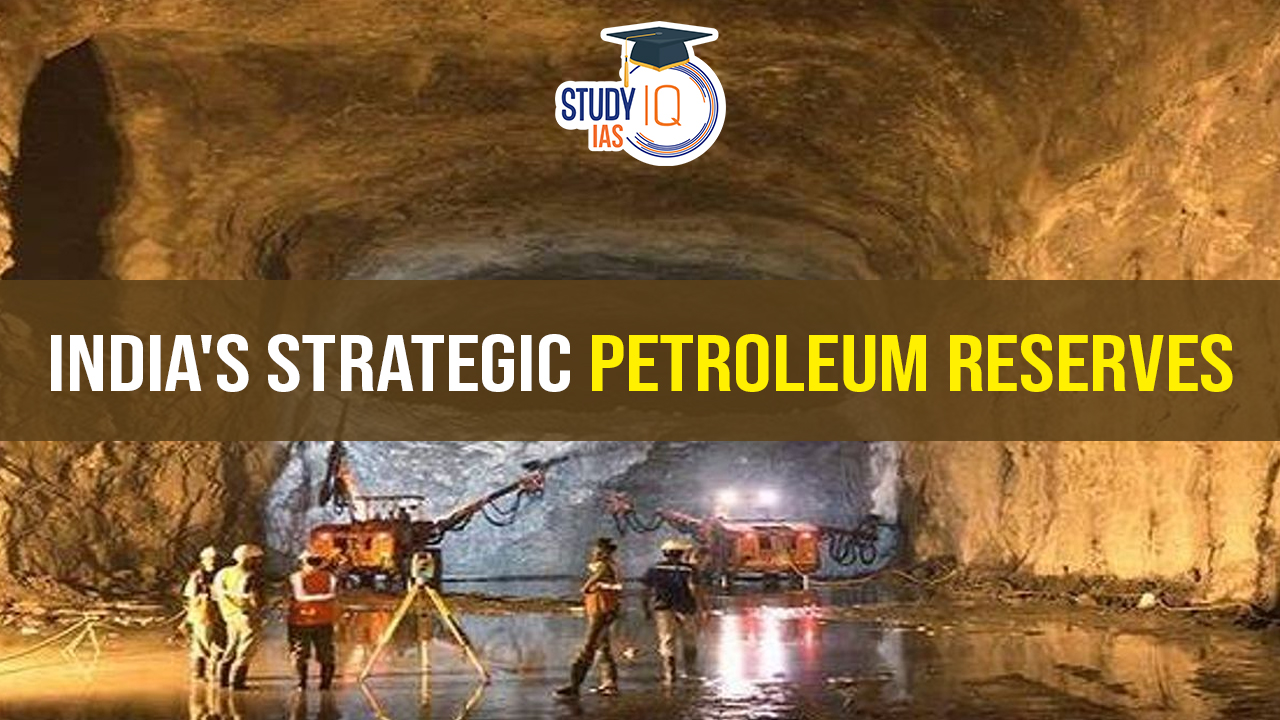Table of Contents
India’s Strategic Petroleum Reserves
In an increasingly interconnected world, energy security stands as a paramount concern for nations striving for sustainable development and economic stability. Among the various measures taken to mitigate energy-related risks, strategic petroleum reserves (SPRs) have emerged as indispensable assets, ensuring a stable supply of crude oil even in the face of geopolitical uncertainties or supply disruptions. India, cognizant of its energy vulnerabilities as the world’s third-largest oil consumer and importer, has embarked on a strategic journey to bolster its energy security through the establishment of strategic petroleum reserves.
What is Strategic Petroleum Reserves (SPRs)?
Strategic Petroleum Reserves (SPRs) are stockpiles of crude oil maintained by governments to ensure energy security during emergencies or supply disruptions. Serving as a buffer against geopolitical uncertainties and market volatility, SPRs stabilize prices and support national defense. Typically stored in underground facilities, SPRs fulfill international obligations while offering a strategic asset for economic resilience and stability. Regular maintenance and replenishment ensure readiness, enabling rapid response to crises and safeguarding vital sectors against oil supply disruptions. Overall, SPRs play a crucial role in mitigating risks and maintaining stability in the global energy market.
India’s Strategic Petroleum Reserves Initiative
India’s foray into strategic petroleum reserves dates back to the late 1990s when the country faced a significant energy crisis during the Gulf War. At that time, India’s existing oil reserves were deemed insufficient, exposing the nation to potential vulnerabilities. Recognizing the urgent need to bolster energy security, the Indian government under the leadership of Atal Bihari Vajpayee laid the groundwork for establishing strategic petroleum reserves.
In 2004, Indian Strategic Petroleum Reserves Ltd. (ISPRL) was formed as a Special Purpose Vehicle (SPV) under the Ministry of Petroleum & Natural Gas to oversee the construction and operation of SPR facilities. Since then, India has made significant strides in expanding its SPR infrastructure to enhance energy resilience.
We’re now on WhatsApp. Click to Join
First Commercial Crude Oil Strategic Storage of India
India is set to construct its inaugural commercial crude oil strategic storage facility, signaling a pivotal step in bolstering the nation’s energy security. This initiative underscores India’s proactive stance in fortifying its reserves against potential supply disruptions and geopolitical uncertainties. By establishing its first commercial storage facility, India aims to enhance its capacity to stockpile crude oil, ensuring a stable supply to meet domestic demands even in the face of unforeseen challenges.
Rationale for Establishing SPRs in India
- India, as one of the world’s largest and fastest-growing economies, heavily relies on oil imports to meet its energy needs.
- Geopolitical uncertainties, volatile oil markets, and potential supply disruptions pose significant risks to India’s energy security.
- Establishing SPRs is imperative to mitigate these risks and ensure uninterrupted access to essential energy resources.
Historical Context
- The idea of establishing strategic petroleum reserves in India emerged during the Gulf War in 1990 when the country faced a severe energy crisis.
- The administration led by Atal Bihari Vajpayee laid the groundwork for developing SPRs to address energy insecurity and vulnerabilities.
Formation of Indian Strategic Petroleum Reserves Ltd. (ISPRL)
- ISPRL was created as a Special Purpose Vehicle (SPV) under the Ministry of Petroleum & Natural Gas in 2004.
- It is entrusted with the responsibility of constructing, maintaining, and operating SPR facilities across India.
Current Infrastructure
- India’s existing underground SPR facilities are strategically located in Visakhapatnam, Andhra Pradesh (1.33 MMT capacity), Mangaluru, Karnataka (1.5 MMT capacity), and Padur, Karnataka (2.5 MMT capacity).
- These facilities have a combined storage capacity of 5.33 Million Metric Tonnes (MMT) of crude oil.
Filling Strategy and Cost Savings
- India capitalized on low crude oil prices in April/May 2020 to fill its existing SPR facilities to full capacity.
- This strategic move resulted in substantial cost savings estimated at around INR 5000 crore.
Expansion Plans and Future Prospects
- In July 2021, the Indian government approved the establishment of two additional commercial-cum-strategic SPR facilities in Chandikhol, Odisha (4 MMT capacity), and Padur, Karnataka (2.5 MMT capacity expansion).
- These facilities, operating under a Public Private Partnership (PPP) mode, aim to augment India’s total storage capacity to 6.5 MMT, thereby enhancing energy resilience.
Importance of SPRs for Energy Security
- Risk Mitigation: SPRs cushion against supply disruptions due to geopolitical tensions or natural disasters.
- Economic Stability: Ensures uninterrupted energy supply, averting crises and sustaining industrial activities.
- Geopolitical Resilience: Reduces vulnerability to external pressures, enhancing sovereignty.
- Strategic Resource: Vital for national security, reducing dependence on volatile international markets.
- Emergency Response: Provides immediate access to essential energy resources during emergencies, bolstering resilience.
- Market Stability: Helps stabilize oil markets by releasing reserves during crises, preventing price spikes.
- Global Cooperation: Encourages international collaboration through collective action in releasing emergency stocks.
- Long-term Planning: Essential component of energy policy, ensuring preparedness for future uncertainties.
India’s Strategic Petroleum Reserves UPSC
- India’s strategic petroleum reserves initiative reflects the nation’s proactive approach towards safeguarding its energy security and sovereignty.
- By expanding SPR infrastructure, leveraging market opportunities, and fostering partnerships, India is poised to strengthen its resilience to energy-related risks and uncertainties.


 List of Indian State Animals with their ...
List of Indian State Animals with their ...
 World Heritage Day 2025, Theme, Objectiv...
World Heritage Day 2025, Theme, Objectiv...
 World Hemophilia Day 2025: Theme, Histor...
World Hemophilia Day 2025: Theme, Histor...





















